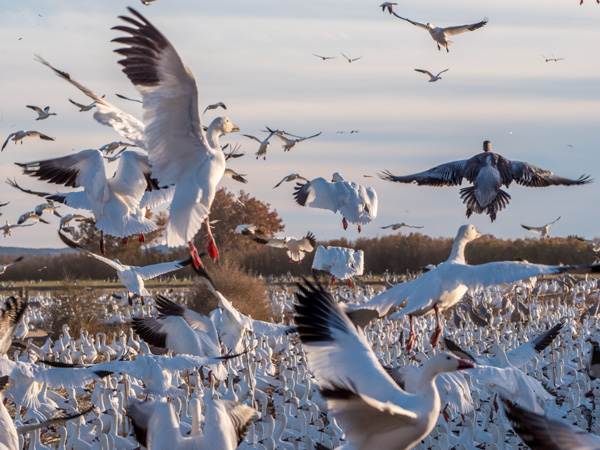
by successfulbob | bird photography, Lumix G9, LumixGH5, photography, photography gear, travel photography, wildlife photography
Bosque Del Apache National Wildlife Refuge
Snow Geese Part Two
With twenty-thousand plus snow geese winging their way around the Bosque Del Apache National Wildlife Refuge it was a fantastic couple of days of sights and sounds. Sometimes it was quite overwhelming. On several occasions I had to put the cameras down to just experience nature in its pure form.
I’ve found there is a layer of distance that appears much larger than the six to eight physical inches when I put my face behind a camera — a certain detachment. This distance enables other photographers and me to do things like cover disasters, wars or record infant demises through organizations such as **Now I Lay Me Down To Sleep. This is an important feature, but it can occasionally interfere with the enjoyment of the moment that is unfolding in front of us.
More Snow Geese photos to share…
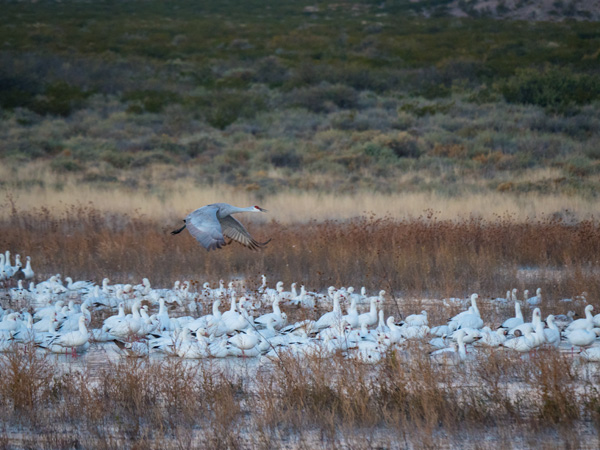 A solitary Sandhill Crane glides in over a pond of snow geese
A solitary Sandhill Crane glides in over a pond of snow geese
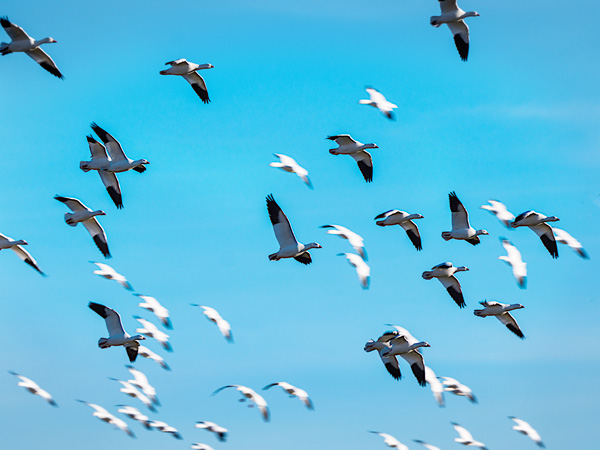 Snow geese in flight
Snow geese in flight
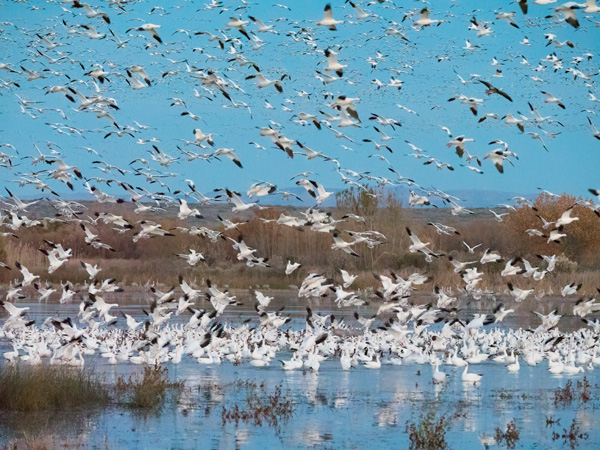 Take off!
Take off!
 Kinda reminds me of that famous movie from Alfred Hitchcock!
Kinda reminds me of that famous movie from Alfred Hitchcock!
To make successful wildlife photographs, I would suggest that you spend a fair amount of time studying their behavior long before you pick up your camera to try and capture images. I’m a big fan of bird behavior vs. a straight portrait, although portraits have their place. Being able to predict when a bird will fly, open its wings or display for another will make your photographs come to life. Having a lens with a long reach works to help you fill the frame without disturbing the natural behavior. See my gear below which gives me an 800mm equivalent which is handholdable for capture.
Images were made with Panasonic cameras. Most often the LUMIX G Leica DG Vario-Elmar Professional Lens, 100-400MM, F4.0-6.3 ASPH mounted on the Lumix G9 and the Lumix GH5 for a second body. I had the chance to try out the Leica DG Vario-Elamarit 50-200mm 2.8-40 lens I am working toward getting this lens.
Next up the Sandhill Cranes!!
Yours in Creative Photography, Bob
** If you want to give back to your community think about photographing for NILMDTS. It is a very rewarding, if difficult mission.
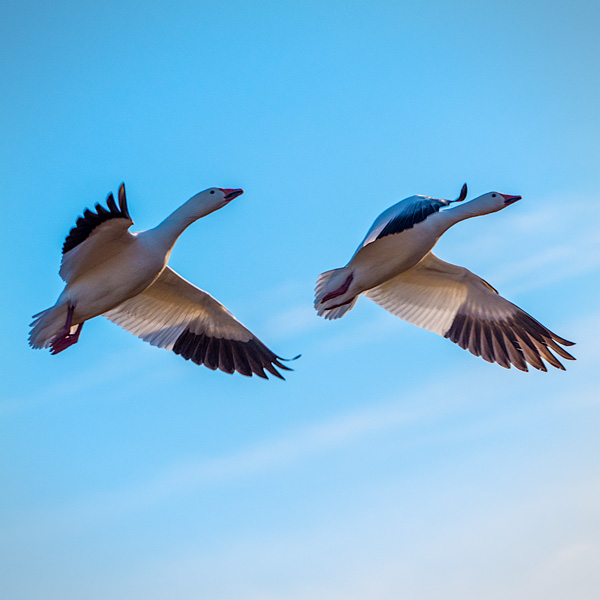
by successfulbob | bird photography, Lumix G9, LumixGH5, photography, photography gear, travel photography, wildlife photography
Festival of the Cranes
Bosque Del Apache National Wildlife Refuge
White Snow Geese must have gotten the invitation too.
I was in Socorro, New Mexico at the Festival of the Cranes hanging with the massive flocks of birds and a mass of photographers. Gotta tell you I felt like the Snow Goose whisperer during my workshop. The 10,000-plus Snow geese seemed to be following me around the refuge. Seeing them move as a group and fly mass ascensions from place to place was magical! Here are a few photos to help visually tell the story.
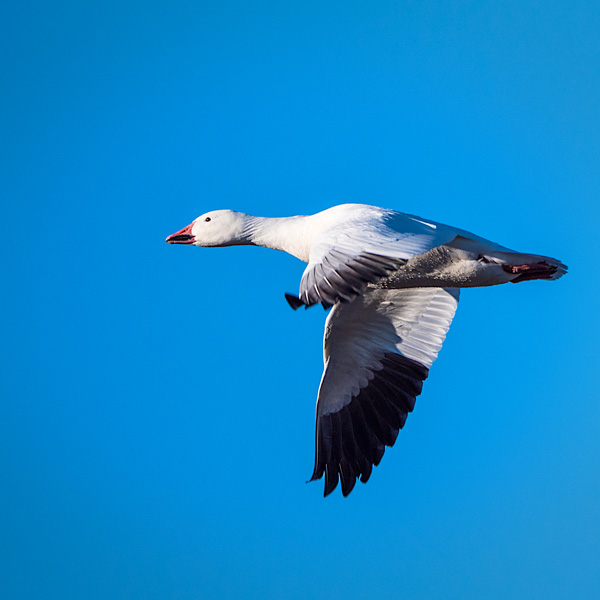 If you look closely, you can see the water droplets on the goose’s body
If you look closely, you can see the water droplets on the goose’s body
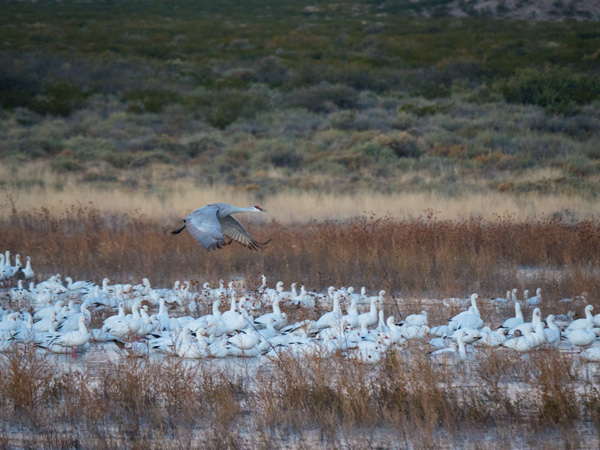 A sandhill crane works to land over a pile of snow geese. The guides at the Festival of the Cranes consider the geese interlopers. (And there were about 20,000 plus!)
A sandhill crane works to land over a pile of snow geese. The guides at the Festival of the Cranes consider the geese interlopers. (And there were about 20,000 plus!)
 A pair of snow geese in flight
A pair of snow geese in flight
This trip is my second time at the Bosque Del Apache National Wildlife Preserve, and I certainly hope it won’t be my last. It is a well-managed area with wildlife throughout the year. Each year the cranes and geese return on their annual migration just before Thanksgiving. It is a sight to behold when 20,000 geese take to the air. I’ll share some photos of that spectacle in a day or so. To tell the truth, I stopped making images for a while to experience the display of so many birds in flight, or as my friend, Skip Cohen says, “Take ‘Neurochromes’ and burn the images into your brain.”
Images were made with Panasonic cameras. Most often the LUMIX G Leica DG Vario-Elmar Professional Lens, 100-400MM, F4.0-6.3 ASPH mounted on the Lumix G9 and the Lumix GH5 for a second body. I had the chance to try out the Leica DG Vario-Elamarit 50-200mm 2.8-40 lens I am now lusting after this… A sweet piece of glass!
Have a happy Thanksgiving!
Yours in Creative Photography, Bob
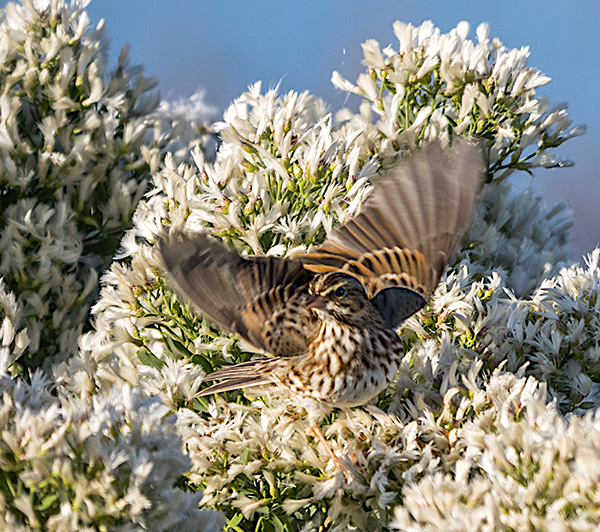
by successfulbob | bird photography, Lumix G9, photography, photography gear, travel photography, wildlife photography
Bombay Hook National Wildlife Refuge – Smyrna, Delaware
I’ve been a bit remiss in posting. Travel for speaking. Travel for family visit. And catching up upon return fronfrom the travel makes Bob a bad boy. But, I’m back and with plans to have more posts even when traveling to judge images &speak in Oregon and do a seminar and a couple workshops for the Festival of the Cranes in Socorro, New Mexico in the middle of November. We’ll see how that works out!
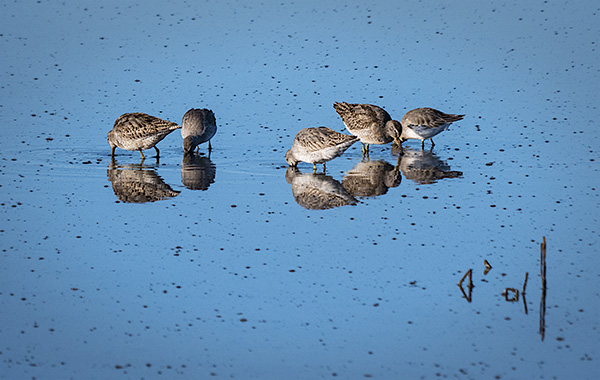 Dunlin Sandpipers enjoying breakfast
Dunlin Sandpipers enjoying breakfast
While on the family visit I made it up to the Bombay Hook National Wildlife Refuge. I spent the day making images and talking photography with my friend Ned Levi. This was the first time we met in person. I highly recommend spending quality time with your peers. It’s wonderful how much you can learn from each other. (learn more about Ned and his blog)
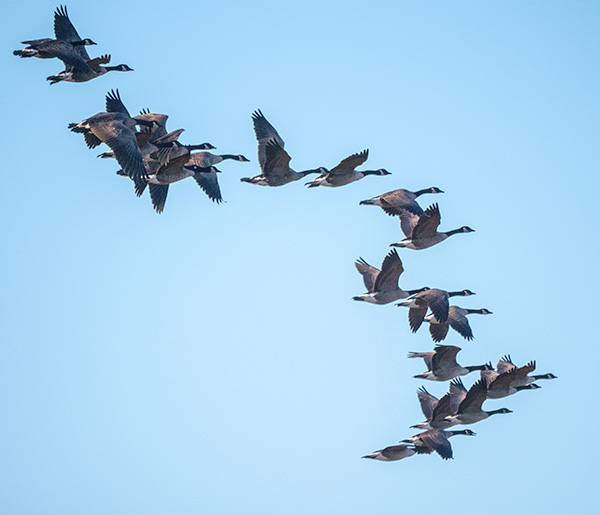 Thought this was an interesting formation of the Canada Geese. I normally enjoy them mor eisolatedbut the overlap of the birds is kida cool. Watcha’ think??
Thought this was an interesting formation of the Canada Geese. I normally enjoy them mor eisolatedbut the overlap of the birds is kida cool. Watcha’ think??
If you have not spent time in wildlife refuges there are some protocols that make the system work for everyone. If you do go please follow the rules and regs. use the longest lens you have and do your best to not disturb the wildlife. There’s an expression, “Take only images, leave only footprints.” Not sure I have the exact words but you understand the sentiment.
This is from the Refuge website and the rules are much the same in all refuges.
Know Before You Go
- The wildlife drive is open from 1/2 hour before sunrise to 1/2 hour after sunset daily.
- The visitor center is open weekdays from 8:00 a.m. to 4:00 p.m. year round.
- During spring and fall weekends, the visitor center is open Saturday and Sunday from 9:00 a.m. to 5:00 p.m.
- The visitor center is handicapped accessible and has educational displays and videos.
- The visitor center is closed on Federal Holidays.
- The visitor center is closed on weekends during July, August, mid-December, January, and February.
- Check the website or call to find out about refuge road closures during bad weather and hunting season. During summer months, visitor should bring insect repellent and wear long-sleeve shirts and long pants.
- To protect wildlife and their habitat and to provide the best opportunities in wildlife observation and photography, it is important not to disturb, injure, or damage plants and animals on the refuge. In fact, it is a prohibited act as stated in 50 CFR 27.51. This disturbance includes flushing birds and other wildlife or using mechanical or electronic devices to lure birds closer for observation or photography. Please remember to take only memories and photographs and leave only footprints.
- Unmanned aircraft systems (Drones) are prohibited.
 A simple houe wren was dancing in and out of the flowering bush. Behavior and movement photos are my aim.
A simple houe wren was dancing in and out of the flowering bush. Behavior and movement photos are my aim.
Images were made with the PANASONIC LUMIX G Leica DG Vario-Elmar Professional Lens, 100-400MM, F4.0-6.3 ASPH mounted on the Lumix G9.
Yours in Creative Photography, bob
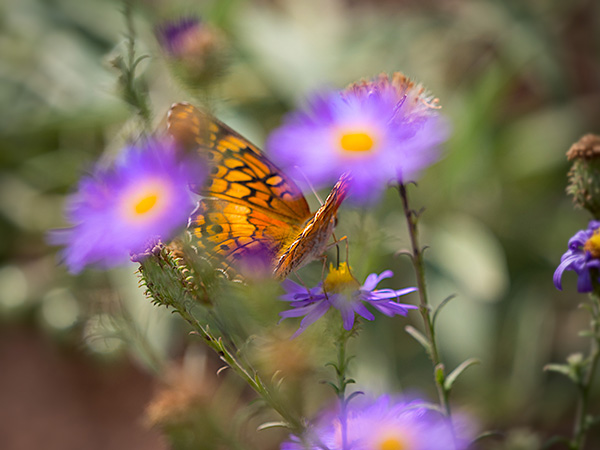
by successfulbob | bird photography, flower photography, Lumix G9, photo walkabout, photography, photography gear, wildlife photography
Long Lens Photography – 100-400mm
I enjoy my long lens for outdoor photography. It’s a beautiful piece of equipment for isolating subjects against a background with nice bokeh. The longer the lens, the easier it is to have an out-of-focus background. The PANASONIC LUMIX G Leica DG Vario-Elmar Professional Lens, 100-400MM, F4.0-6.3 ASPH is a magical lens IMHO.
Here are some images from a walkabout at the Sedona Wetlands. I didn’t find many waterfowl as it was midday and possibly the wrong time of year. In any case, I always try to make the best of any photography situation and started looking for details. There are still some wildflowers scattered throughout. This attracts butterflies, birds, and bees.
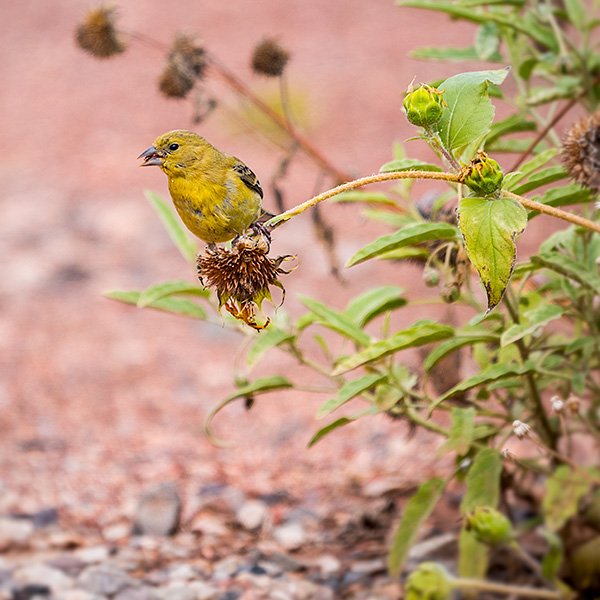 Adult female Lesser Goldfinch snacking on some wildflowers that have gone to seed
Adult female Lesser Goldfinch snacking on some wildflowers that have gone to seed
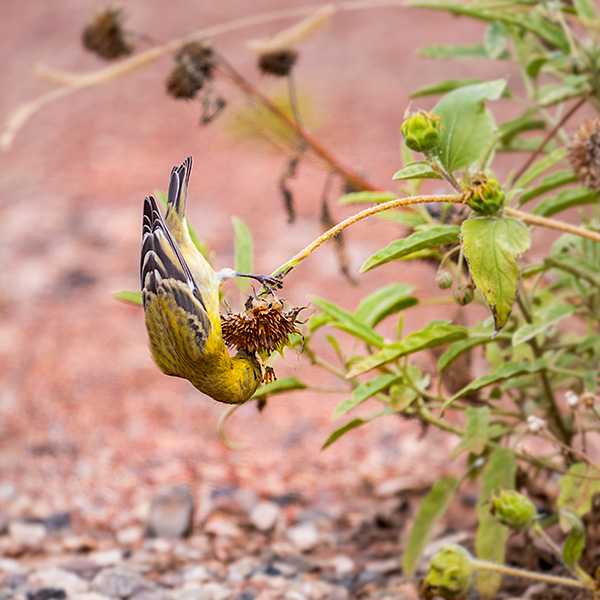 I always look to capture ‘behavior’ photos as well as straight portraits of my feathered friends. Here the Lesser Goldfinch is working to get the seeds free from the plant.
I always look to capture ‘behavior’ photos as well as straight portraits of my feathered friends. Here the Lesser Goldfinch is working to get the seeds free from the plant.
 Butterfly caught with shallow depth of field between the plants.
Butterfly caught with shallow depth of field between the plants.
The butterfly photo was my favorite photo of the day. If you’ve chased butterflies in the wild, you know how difficult it can be to get an interesting image. I tracked this one for a while and looked to ‘sandwich’ the butterfly with DOF. I wanted a sharp subject surrounded by the in and out of focus flowers. This was made more difficult as there were not a ton of flowers in bloom and the wind was making the flowers dance as well. Now that I see the image here I’ll crop in a little tighter and loose the past prime flowers on the right-hand side of the photo.
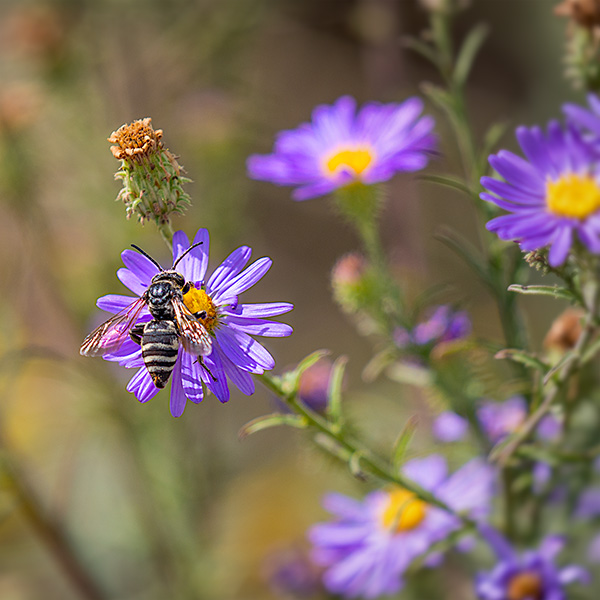 Wasps one of our other pollinators were flitting between the blooms as well as the butterflies.
Wasps one of our other pollinators were flitting between the blooms as well as the butterflies.
I choose this one to share as it has a different color with black and white stripes.
Back to the lens. One complaint I hear about the lens is that it is very stiff to zoom. It was designed that way not to suffer ‘lens creep’ when you hang it from your shoulder. I’ve found a perfect way to change the zoom. Instead of trying to turn the lens, hold the lens and turn the camera. It’s like opening a bottle of champagne where you hold the cork and twist the bottle. Makes it easy and you don’t end up with the lens creep!
When paired with the Lumix G9 you get 6 and a half stops of handholdability. All images were handheld in this post.
Yours in Creative Photography, Bob
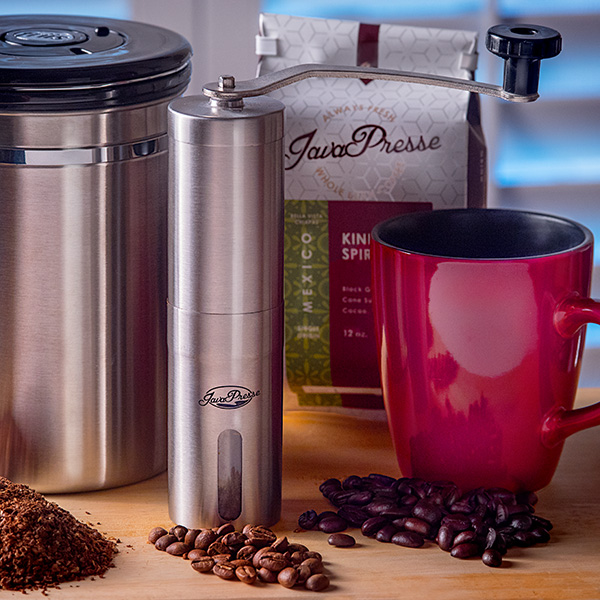
by successfulbob | commercial photography, Lumix G9, photography, photography creativity, photography education, photography gear, photography lighting resources
Java Presse – Coffee Shoot
The Genesis of a Commercial Shoot
Not quite ‘nectar of the gods’ but I’ve found some serious joy in my morning coffee. It was a gradual process to see the pleasure I now have in the morning ritual and enjoyment of grinding beans, brewing and enjoying coffee.
 Java Presse Coffee image square format final crop
Java Presse Coffee image square format final crop
It started with some friends showing the benefits of grinding beans for French Press coffee. Good stuff.
I found myself getting frustrated with the ‘static cling’ that was generated by using an electric grinder that had a plastic bin for catching the grounds and left little trails of tiny grounds scattered along the counter. This led to looking for a mill that had a stainless steel basket. Research showed that prices were more than I wanted to pay. Which turned out to be a good thing! Because that led me to the stainless steel coffee grinder from Java Presse.
The grinder led me to lots more information about the whole process of roasting coffee, the freshness of the beans and proper preparation for the French Press that I use. Thanks to Java Presse the entire experience has turned my morning coffee into an enjoyable ritual. And who knew that freshly roasted beans, ground fresh just before brewing could make such a difference.
I’m a coffee convert.
Photography Process
And, now on the photography section of the making of a commercial image of the product. You can see the final photo at the top of the post above. Below is how the photo was built.
Good, solid commercial images should look effortless and clean. It takes a bit more to achieve the look. I make this happen by creating several images with different lighting patterns which are later combined in Adobe Photoshop. This comes in handy for items that have different levels of reflectance such as the stainless steel of the grinder and coffee storage container as well as making sure logos are readable.
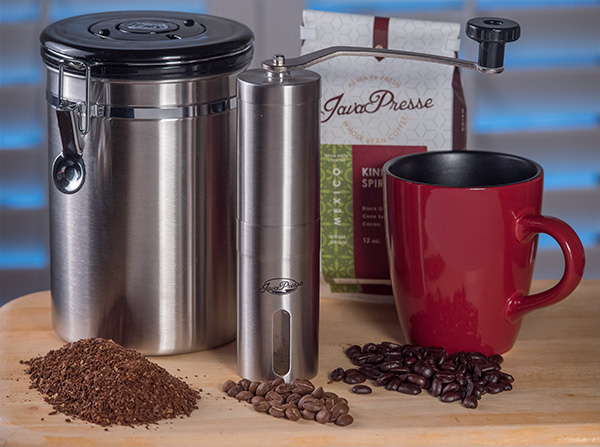 Note the harsh light patterns in the metal especially the one crossing through the logo on the grinder
Note the harsh light patterns in the metal especially the one crossing through the logo on the grinder
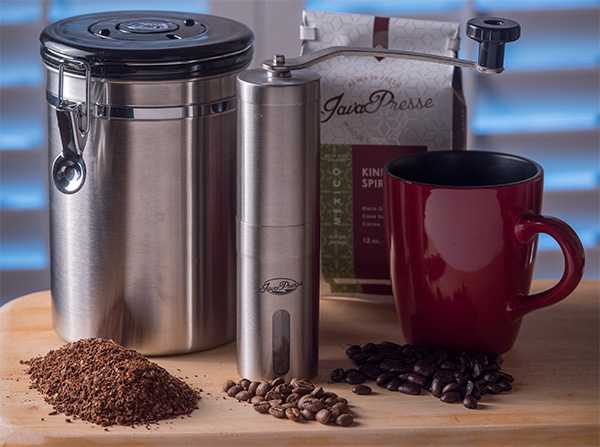 Using a reflector I reshot the scene to give more pleasing light on the stainless steel, but now the reflections that give the image life are gone
Using a reflector I reshot the scene to give more pleasing light on the stainless steel, but now the reflections that give the image life are gone
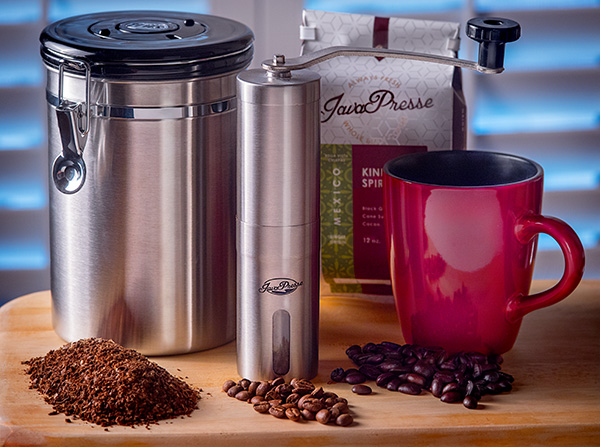 See the difference between the two blended images. Logos are a much easier read, and there are highlights right where they are needed without distraction
See the difference between the two blended images. Logos are a much easier read, and there are highlights right where they are needed without distraction
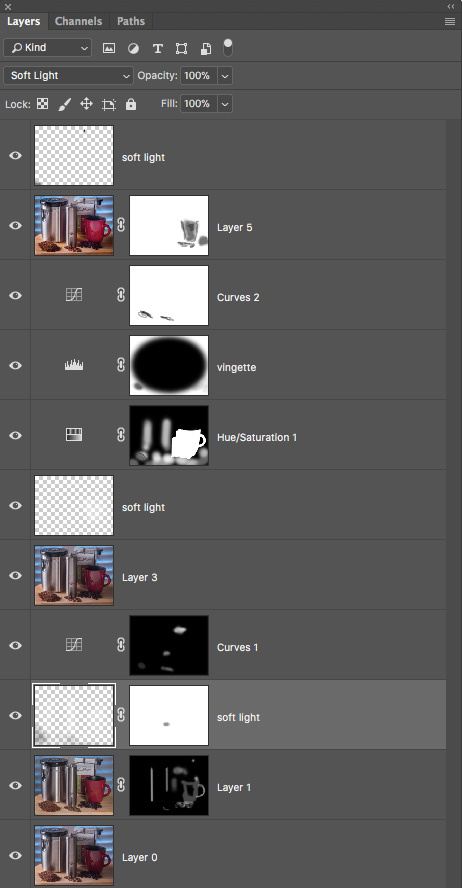 Photoshop Layers Palette is showing some of the work with Masks used to help create the final image.
Photoshop Layers Palette is showing some of the work with Masks used to help create the final image.
I also used Skylum software (formerly MacPhun) software called Focus CK. CK stands for Creative Kit. It is a very handy sharpening and blurring tool for directing attention where you want. I often use the ‘Macro’ setting on its layer and mask in what I need.
Yours in Creative Photography, Bob
PS – Here’s the gear I used in this shoot.
2 Fiilex LED lights with softboxes
Lumix G9
LUMIX G X VARIO LENS, 35-100MM, F2.8 ASPH
White foam core panel
Posing table
Tripod Necessary for keeping images in registration for compositing the lighting
Ball head for tripod – Siri Model K-20X
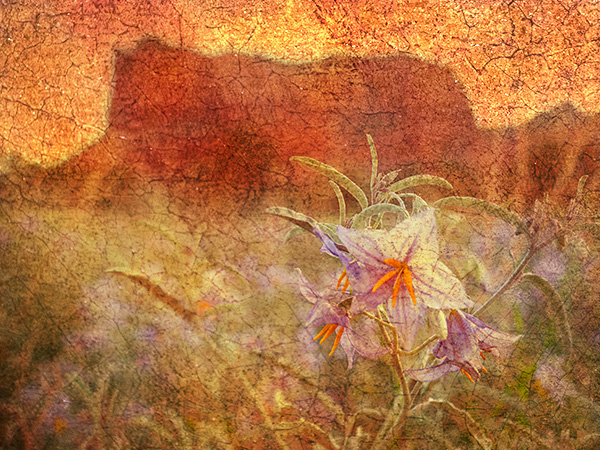
by successfulbob | landscape photography, Lumix G9, photography creativity, photography gear
Interpreting the Red Rocks – Juuuust a Little Different
If you have followed this blog and my work for any length of time you know that I often like to take my images further than a ‘straight’ photograph. I have found a weird thing while working on this process. There are times to get a certain look you need to make what I would normally consider a ‘bad’ photograph. One that is either under or overexposed to create the vision in your using certain textures.
Here’s a case in point. The density range for this image was huge in that I was shooting the flower in the shade and the background was in full sun. I originally bracketed this scene to get a ‘correct’ exposure. I processed that, but when I went to work, I found that I had better results with the image that was a single exposure rather than having all the detail that Aurora HDR 2018 software would provide.
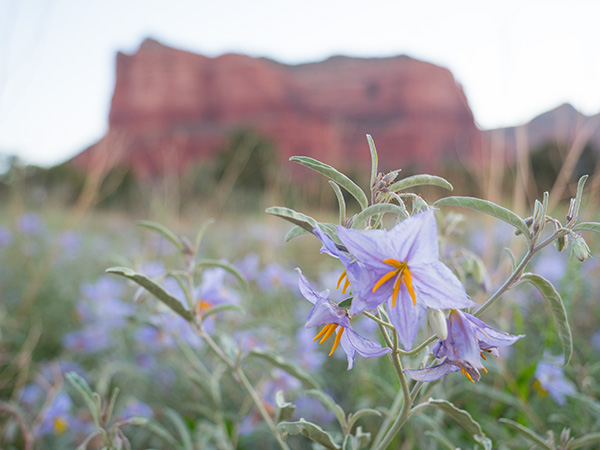 Here is one of the bracketed images slightly over-exposed. Little to no detail in the sky.
Here is one of the bracketed images slightly over-exposed. Little to no detail in the sky.
The little to no detail in the sky gives the texture a chance to shine. I used texture from a small section of an old painting in various blend modes to achieve the image below.
 Here is my artistic rendition of the image.
Here is my artistic rendition of the image.
I think the plain image needed some help other than making a full range of tones visible. I work photos in many different ways before I find the vision for which I was looking.
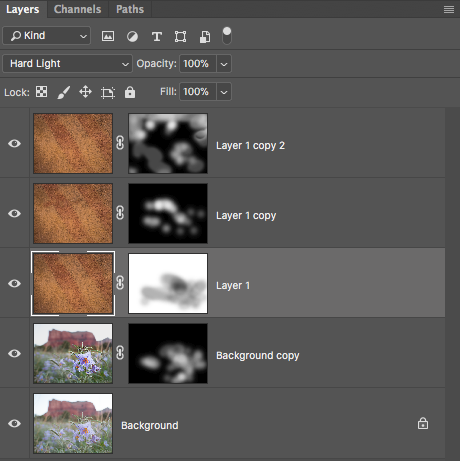 Here is the Photoshop Layers Palette from the image above. Note: all Layers had a different blend mode applied and Masks were used to extract or cover the information I did or didn’t want.
Here is the Photoshop Layers Palette from the image above. Note: all Layers had a different blend mode applied and Masks were used to extract or cover the information I did or didn’t want.
Lumix G9 with the Leica DG Vario-ELMARIT Professional Lens, 12-60MM, F2.8-4.0 was used for this capture. The fully articulating screen is helpful when framing an image where the camera is low to the ground. Saves getting down to try and look through the viewfinder and also save work in the laundry for clothes that have been doused in dirt!
Yours in Creative Photography, Bob

 A solitary Sandhill Crane glides in over a pond of snow geese
A solitary Sandhill Crane glides in over a pond of snow geese Kinda reminds me of that famous movie from Alfred Hitchcock!
Kinda reminds me of that famous movie from Alfred Hitchcock!
























